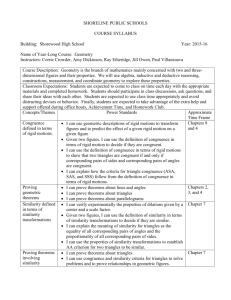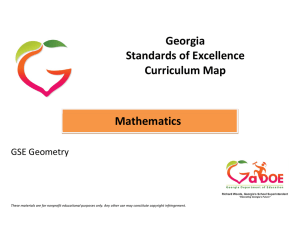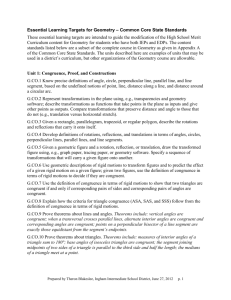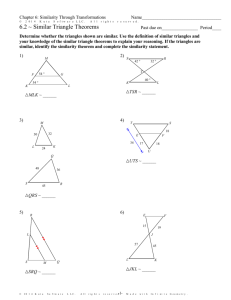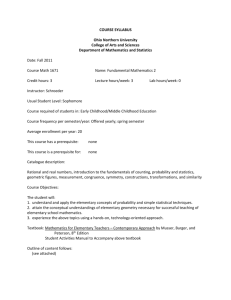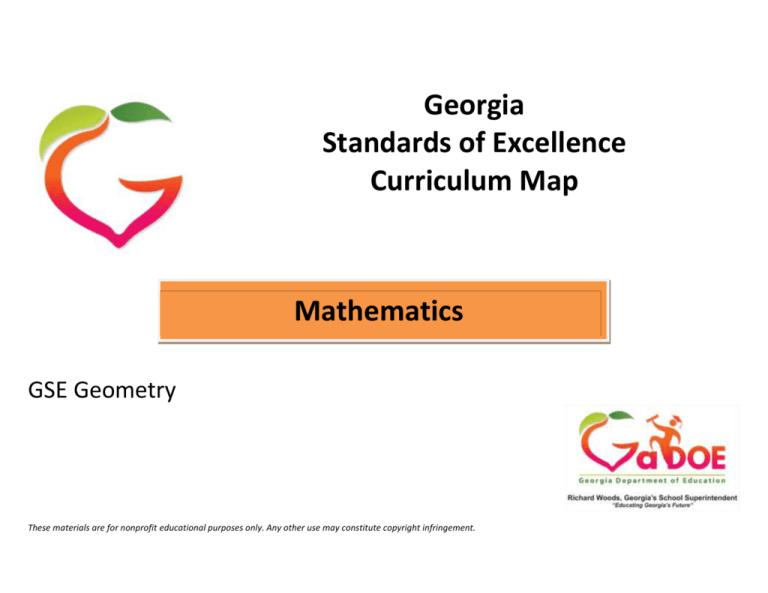
Georgia
Standards of Excellence
Curriculum Map
Mathematics
GSE Geometry
These materials are for nonprofit educational purposes only. Any other use may constitute copyright infringement.
Georgia Department of Education
GSE Geometry Curriculum Map
1st Semester
2nd Semester
Unit 1
(2 –3 weeks)
Unit 2
(9 – 10 weeks)
Unit 3
(3 – 4 weeks)
Unit 4
(6 – 7 weeks)
Unit 5
(4 – 5 weeks)
Unit 6
(4 – 5 weeks)
Transformations in the
Coordinate Plane
Similarity,
Congruence, and
Proofs
Right Triangle
Trigonometry
Circles and Volume
Geometric and
Algebraic Connections
Applications of
Probability
MGSE9-12.G.CO.1
MGSE9-12.G.CO.2
MGSE9-12.G.CO.3
MGSE9-12.G.CO.4
MGSE9-12.G.CO.5
MGSE9-12.G.SRT.1
MGSE9-12.G.SRT.2
MGSE9-12.G.SRT.3
MGSE9-12.G.SRT.4
MGSE9-12.G.SRT.5
MGSE9-12.G.CO.6
MGSE9-12.G.CO.7
MGSE9-12.G.CO.8
MGSE9-12.G.CO.9
MGSE9-12.G.CO.10
MGSE9-12.G.CO.11
MGSE9-12.G.CO.12
MGSE9-12.G.CO.13
MGSE9-12.G.SRT.6
MGSE9-12.G.SRT.7
MGSE9-12.G.SRT.8
MGSE9-12.G.C.1
MGSE9-12.G.C.2
MGSE9-12.G.C.3
MGSE9-12.G.C.4
MGSE9-12.G.C.5
MGSE9-12.G.GMD.1
MGSE9-12.G.GMD.2
MGSE9-12.G.GMD.3
MGSE9-12.G.GMD.4
MGSE9-12.G.GPE.1
MGSE9-12.G.GPE.4
MGSE9-12.G.GPE.5
MGSE9-12.G.GPE.6
MGSE9-12.G.GPE.7
MGSE9-12.G.MG.1
MGSE9-12.G.MG.2
MGSE9-12.G.MG.3
MGSE9-12.S.CP.1
MGSE9-12.S.CP.2
MGSE9-12.S.CP.3
MGSE9-12.S.CP.4
MGSE9-12.S.CP.5
MGSE9-12.S.CP.6
MGSE9-12.S.CP.7
These units were written to build upon concepts from prior units, so later units contain tasks that depend upon the concepts addressed in earlier units.
All units will include the Mathematical Practices and indicate skills to maintain.
*Revised standards indicated in bold red font.
NOTE: Mathematical standards are interwoven and should be addressed throughout the year in as many different units and tasks as possible in order to stress the natural connections that exist among mathematical topics.
Grade 9-12 Key:
Number and Quantity Strand: RN = The Real Number System, Q = Quantities, CN = Complex Number System, VM = Vector and Matrix Quantities
Algebra Strand: SSE = Seeing Structure in Expressions, APR = Arithmetic with Polynomial and Rational Expressions, CED = Creating Equations, REI = Reasoning with Equations and Inequalities
Functions Strand: IF = Interpreting Functions, LE = Linear and Exponential Models, BF = Building Functions, TF = Trigonometric Functions
Geometry Strand: CO = Congruence, SRT = Similarity, Right Triangles, and Trigonometry, C = Circles, GPE = Expressing Geometric Properties with Equations, GMD = Geometric Measurement and Dimension,
MG = Modeling with Geometry
Statistics and Probability Strand: ID = Interpreting Categorical and Quantitative Data, IC = Making Inferences and Justifying Conclusions, CP = Conditional Probability and the Rules of Probability, MD = Using Probability
to Make Decisions
Richard Woods, State School Superintendent
July 2015
All Rights Reserved
Georgia Department of Education
Georgia Standards of Excellence Geometry
Curriculum Map Rationale
Unit 1: Building on standards from middle school, students will perform transformations in the coordinate plane, describe a sequence of transformations
that will map one figure onto another, and describe transformations that will map a figure onto itself. Students will compare transformations that
preserve distance and angle to those that do not.
Unit 2: Building on standards from Unit 1 and from middle school, students will use transformations and proportional reasoning to develop a formal
understanding of similarity and congruence. Students will identify criteria for similarity and congruence of triangles, develop facility with geometric
proofs (variety of formats), and use the concepts of similarity and congruence to prove theorems involving lines, angles, triangles, and other polygons.
Unit 3: Students will apply similarity in right triangles to understand right triangle trigonometry. Students will use the Pythagorean Theorem and the
relationship between the sine and cosine of complementary angles to solve problems involving right triangles.
Unit 4: Students will understand and apply theorems about circles, find arc lengths of circles, and find areas of sectors of circles. Students will develop
and explain formulas related to circles and the volume of solid figures and use the formulas to solve problems. Building on standards from middle
school, students will extend the study of identifying cross-sections of three-dimensional shapes to identifying three-dimensional objects generated by
rotations of two-dimensional objects.
Unit 5: Students will use the concepts of distance, midpoint, and slope to verify algebraically geometric relationships of figures in the coordinate plane
(triangles, quadrilaterals, and circles). Students will solve problems involving parallel and perpendicular lines, perimeters and areas of polygons, and the
partitioning of a segment in a given ratio. Students will derive the equation of a circle and model real-world objects using geometric shapes and
concepts.
Unit 6: Students will understand independence and conditional probability and use them to interpret data. Building on standards from middle school,
students will formalize the rules of probability and use the rules to compute probabilities of compound events in a uniform probability model.
Richard Woods, State School Superintendent
July 2015
All Rights Reserved
Georgia Department of Education
GSE Geometry Expanded Curriculum Map – 1st Semester
1 Make sense of problems and persevere in solving them.
2 Reason abstractly and quantitatively.
3 Construct viable arguments and critique the reasoning of others.
4 Model with mathematics.
Unit 1
Standards for Mathematical Practice
5 Use appropriate tools strategically.
6 Attend to precision.
7 Look for and make use of structure.
8 Look for and express regularity in repeated reasoning.
1st Semester
Unit 2
Unit 3
Transformations in the Coordinate Plane
Similarity, Congruence, and Proofs
Right Triangle Trigonometry
Experiment with transformations in the plane
MGSE9-12.G.CO.1 Know precise definitions of angle, circle,
perpendicular line, parallel line, and line segment, based on the
undefined notions of point, line, distance along a line, and
distance around a circular arc.
MGSE9-12.G.CO.2 Represent transformations in the plane
using, e.g., transparencies and geometry software; describe
transformations as functions that take points in the plane as
inputs and give other points as outputs. Compare
transformations that preserve distance and angle to those that
do not
(e.g., translation versus horizontal stretch).
MGSE9-12.G.CO.3 Given a rectangle, parallelogram,
trapezoid, or regular polygon, describe the rotations and
reflections that carry it onto itself.
MGSE9-12.G.CO.4 Develop definitions of rotations,
reflections, and translations in terms of angles, circles,
perpendicular lines, parallel lines, and line segments.
MGSE9-12.G.CO.5 Given a geometric figure and a rotation,
reflection, or translation, draw the transformed figure using,
e.g., graph paper, tracing paper, or geometry software. Specify
a sequence of transformations that will carry a given figure
onto another.
Understand similarity in terms of similarity
transformations
MGSE9-12.G.SRT.1 Verify experimentally the properties
of dilations given by a center and a scale factor.
a. The dilation of a line not passing through the center of
the dilation results in a parallel line and leaves a line
passing through the center unchanged.
b. The dilation of a line segment is longer or shorter
according to the ratio given by the scale factor.
MGSE9-12.G.SRT.2 Given two figures, use the definition
of similarity in terms of similarity transformations to
decide if they are similar; explain, using similarity
transformations, the meaning of similarity for triangles as
the equality of all corresponding pairs of angles and the
proportionality of all corresponding pairs of sides.
MGSE9-12.G.SRT.3 Use the properties of similarity
transformations to establish the AA criterion for two triangles
to be similar.
Prove theorems involving similarity
MGSE9-12.G.SRT.4 Prove theorems about triangles.
Theorems include: a line parallel to one side of a triangle
divides the other two proportionally, (and its converse); the
Pythagorean Theorem using triangle similarity.
MGSE9-12.G.SRT.5 Use congruence and similarity criteria
for triangles to solve problems and to prove relationships in
geometric figures.
Understand congruence in terms of rigid motions
MGSE9-12.G.CO.6 Use geometric descriptions of rigid
motions to transform figures and to predict the effect of a given
rigid motion on a given figure; given two figures, use the
definition of congruence in terms of rigid motions to decide if
they are congruent.
MGSE9-12.G.CO.7 Use the definition of congruence in terms
of rigid motions to show that two triangles are congruent if and
only if corresponding pairs of sides and corresponding pairs of
angles are congruent.
MGSE9-12.G.CO.8 Explain how the criteria for triangle
Define trigonometric ratios and solve problems involving
right triangles
MGSE9-12.G.SRT.6 Understand that by similarity, side ratios
in right triangles are properties of the angles in the triangle,
leading to definitions of trigonometric ratios for acute angles.
MGSE9-12.G.SRT.7 Explain and use the relationship between
the sine and cosine of complementary angles.
MGSE9-12.G.SRT.8 Use trigonometric ratios and the
Pythagorean Theorem to solve right triangles in applied
problems.
Richard Woods, State School Superintendent
July 2015
All Rights Reserved
Georgia Department of Education
congruence (ASA, SAS, and SSS) follow from the definition
of congruence in terms of rigid motions. (Extend to include
HL and AAS.)
Prove geometric theorems
MGSE9-12.G.CO.9 Prove theorems about lines and angles.
Theorems include: vertical angles are congruent; when a
transversal crosses parallel lines, alternate interior angles are
congruent and corresponding angles are congruent; points on a
perpendicular bisector of a line segment are exactly those
equidistant from the segment’s endpoints.
MGSE9-12.G.CO.10 Prove theorems about triangles.
Theorems include: measures of interior angles of a triangle
sum to 180 degrees; base angles of isosceles triangles are
congruent; the segment joining midpoints of two sides of a
triangle is parallel to the third side and half the length; the
medians of a triangle meet at a point.
MGSE9-12.G.CO.11 Prove theorems about parallelograms.
Theorems include: opposite sides are congruent, opposite
angles are congruent, the diagonals of a parallelogram bisect
each other, and conversely, rectangles are parallelograms with
congruent diagonals.
Make geometric constructions
MGSE9-12.G.CO.12 Make formal geometric constructions
with a variety of tools and methods (compass and straightedge,
string, reflective devices, paper folding, dynamic geometric
software, etc.). Copying a segment; copying an angle; bisecting
a segment; bisecting an angle; constructing perpendicular lines,
including the perpendicular bisector of a line segment; and
constructing a line parallel to a given line through a point not
on the line.
MGSE9-12.G.CO.13 Construct an equilateral triangle, a
square, and a regular hexagon, each inscribed in a circle.
Richard Woods, State School Superintendent
July 2015
All Rights Reserved
Georgia Department of Education
GSE Geometry Expanded Curriculum Map – 2nd Semester
1 Make sense of problems and persevere in solving them.
2 Reason abstractly and quantitatively.
3 Construct viable arguments and critique the reasoning of others.
4 Model with mathematics.
Unit 4
Standards for Mathematical Practice
5 Use appropriate tools strategically.
6 Attend to precision.
7 Look for and make use of structure.
8 Look for and express regularity in repeated reasoning.
2nd Semester
Unit 5
Unit 6
Circles and Volume
Geometric and Algebraic Connections
Applications of Probability
Understand and apply theorems about circles
MGSE9-12.G.C.1 Understand that all circles are similar.
MGSE9-12.G.C.2 Identify and describe relationships
among inscribed angles, radii, chords, tangents, and
secants. Include the relationship between central, inscribed,
and circumscribed angles; inscribed angles on a diameter
are right angles; the radius of a circle is perpendicular to
the tangent where the radius intersects the circle.
MGSE9-12.G.C.3 Construct the inscribed and circumscribed
circles of a triangle, and prove properties of angles for a
quadrilateral inscribed in a circle.
MGSE9-12.G.C.4 Construct a tangent line from a point
outside a given circle to the circle.
Find arc lengths and areas of sectors of circles
MGSE9-12.G.C.5 Derive using similarity the fact that the
length of the arc intercepted by an angle is proportional to the
radius, and define the radian measure of the angle as the
constant of proportionality; derive the formula for the area of a
sector.
Explain volume formulas and use them to solve problems
MGSE9-12.G.GMD.1 Give informal arguments for
geometric formulas.
a. Give informal arguments for the formulas of the
circumference of a circle and area of a circle using
dissection arguments and informal limit arguments.
b. Give informal arguments for the formula of the
volume of a cylinder, pyramid, and cone using
Cavalieri’s principle.
MGSE9-12.G.GMD.2 Give an informal argument using
Cavalieri’s principle for the formulas for the volume of a
sphere and other solid figures.
MGSE9-12.G.GMD.3 Use volume formulas for cylinders,
pyramids, cones, and spheres to solve problems.
Visualize relationships between two-dimensional and threedimensional objects
MGSE9-12.G.GMD.4 Identify the shapes of two-dimensional
cross-sections of three-dimensional objects, and identify three-
Translate between the geometric description and the
equation for a conic section
MGSE9-12.G.GPE.1 Derive the equation of a circle of given
center and radius using the Pythagorean Theorem; complete
the square to find the center and radius of a circle given by an
equation.
Use coordinates to prove simple geometric theorems
algebraically
MGSE9-12.G.GPE.4 Use coordinates to prove simple
geometric theorems algebraically. For example, prove or
disprove that a figure defined by four given points in the
coordinate plane is a rectangle; prove or disprove that the
point (1, √3) lies on the circle centered at the origin and
containing the point (0,2).
(Focus on quadrilaterals, right triangles, and circles.)
MGSE9-12.G.GPE.5 Prove the slope criteria for parallel and
perpendicular lines and use them to solve geometric problems
(e.g., find the equation of a line parallel or perpendicular to a
given line that passes through a given point).
MGSE9-12.G.GPE.6 Find the point on a directed line
segment between two given points that partitions the segment
in a given ratio.
MGSE9-12.G.GPE.7 Use coordinates to compute perimeters
of polygons and areas of triangles and rectangles, e.g., using
the distance formula.
Apply geometric concepts in modeling situations
MGSE9-12.G.MG.1 Use geometric shapes, their measures,
and their properties to describe objects
(e.g., modeling a tree trunk or a human torso as a cylinder).
MGSE9-12.G.MG.2 Apply concepts of density based on area
and volume in modeling situations
(e.g., persons per square mile, BTUs per cubic foot).
MGSE9-12.G.MG.3 Apply geometric methods to solve design
problems (e.g., designing an object or structure to satisfy
physical constraints or minimize cost; working with
typographic grid systems based on ratios).
Understand independence and conditional probability and
use them to interpret data
MGSE9-12.S.CP.1 Describe categories of events as subsets
of a sample space using unions, intersections, or
complements of other events (or, and, not).
MGSE9-12.S.CP.2 Understand that if two events A and B
are independent, the probability of A and B occurring
together is the product of their probabilities, and that if the
probability of two events A and B occurring together is the
product of their probabilities, the two events are
independent.
MGSE9-12.S.CP.3 Understand the conditional probability
of A given B as P (A and B)/P(B). Interpret independence
of A and B in terms of conditional probability; that is the
conditional probability of A given B is the same as the
probability of A and the conditional probability of B given
A is the same as the probability of B.
MGSE9-12.S.CP.4 Construct and interpret two-way
frequency tables of data when two categories are associated
with each object being classified. Use the two-way table as a
sample space to decide if events are independent and to
approximate conditional probabilities. For example, use
collected data from a random sample of students in your
school on their favorite subject among math, science, and
English. Estimate the probability that a randomly selected
student from your school will favor science given that the
student is in tenth grade. Do the same for other subjects and
compare the results.
MGSE9-12.S.CP.5 Recognize and explain the concepts of
conditional probability and independence in everyday language
and everyday situations. For example, compare the chance of
having lung cancer if you are a smoker with the chance of
being a smoker if you have lung cancer.
Use the rules of probability to compute probabilities of
compound events in a uniform probability model
MGSE9-12.S.CP.6 Find the conditional probability of A
given B as the fraction of B’s outcomes that also belong to
Richard Woods, State School Superintendent
July 2015
All Rights Reserved
Georgia Department of Education
dimensional objects generated by rotations of two-dimensional
objects.
A, and interpret the answer in context.
MGSE9-12.S.CP.7 Apply the Addition Rule, P(A or B) =
P(A) + P(B) – P(A and B), and interpret the answers in
context.
Richard Woods, State School Superintendent
July 2015
All Rights Reserved

